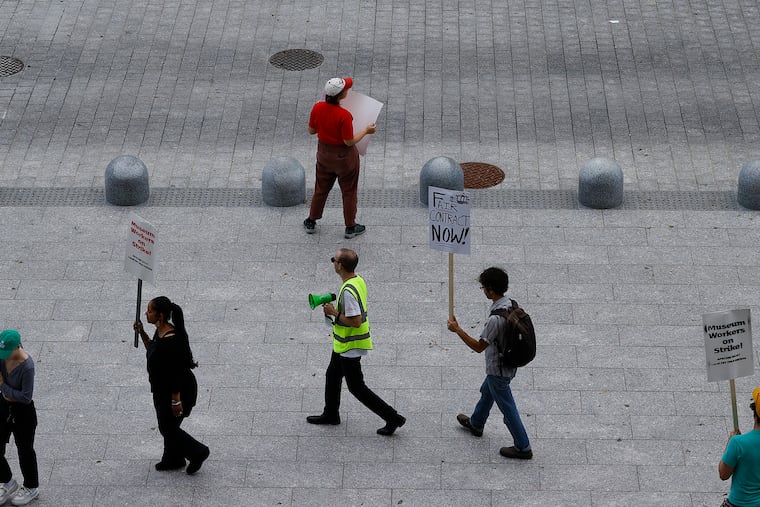Workers at Philadelphia Museum of Art are on strike; museum is open
“After two years of negotiations, our membership cannot accept further stalling and union-busting,” said Local 397 president Adam Rizzo. About 180 art museum employees are members of the union.

More than half the roughly 350 workers at the Philadelphia Museum of Art went on strike Monday, throwing up picket lines at entrances to the main building on the Benjamin Franklin Parkway, at the entrances to the Perelman Building across Kelly Drive, and at the Rodin Museum down the Parkway.
Never before has the Art Museum experienced such a staff-wide walkout. In this instance the museum and the union have been bargaining for about two years without reaching agreement on a first contract.
Museum officials said the museum is open and running on its normal schedule (from 9 a.m. to 5 p.m.) staffed by managers and nonunion employees. It is closed Tuesdays and Wednesdays, reopening Thursday; Fridays have a late 8:45 p.m. closing time.
On Monday morning, a smattering of visitors came and went, in equally small numbers during the middle of the day. One woman from the city said her family was a union family. She did not cross the picket line. Another woman from Chicago said she wanted to see the museum and had only a little time to do so. She entered the museum.
Strikers at both the west and north entrances urged visitors to skip the museum, directing them to the Barnes Foundation down the street.
Leaders of the union, AFSCME DC47, Local 397, called for the strike last Friday, noting that they have bargained with the museum for their first contract since October 2020 without success. Museum workers voted in favor of unionization in July 2020.
“After two years of negotiations, our membership cannot accept further stalling and union-busting,” said Local 397 president Adam Rizzo. There are about 180 Art Museum employees who are members of the union.
Rizzo said union leaders and museum management met for about nine hours on Thursday and another five hours on Friday. The union and museum have another bargaining session this Friday..
“We were able to clear most of the noneconomic issues” at those sessions, Rizzo said Monday.
“The real stumbling block was when we started talking about the economic package and health-care benefits and stuff like that,” Rizzo said. “It became clear that the museum was unwilling to move on really anything at all.”
Museum officials said the museum had offered “significant wage increases” at the bargaining session last week.
In a statement outlining its latest bargaining position, the museum said it had offered workers “wage increases totaling 8.5% over the next 10 months and 11% by July 1, 2024″ and a “minimum annual salary for exempt employees that is more than 10% higher than the current lowest annual salary for these employees.”
The museum said that it had also offered employees four weeks of paid parental leave and accelerated eligibility for health benefits for new hourly employees, allowing those employees to receive medical, dental, and vision coverage up to 60 days earlier than they can today.
In addition, the museum said its latest offer included accelerated vacation accrual for hourly employees, a more flexible remote work schedule, and job-security protections that ensure the museum will not use a temporary employee, term employee, subcontractor, or volunteer to lay off or furlough a current union staff member.
Rizzo said there had been no salary increases for three years, even as inflation has accelerated, “so we’re already behind when you add those numbers up.” And, he said, health-care benefits represented “a big issue,” so far unaddressed. Most workers, he said, were on a “high deductible” plan, which he characterized as so expensive that “most people at the museum” find they cannot afford health care.
Museum officials pointed out that 90% of the health-care plan is paid for by the museum, which also contributes to employees’ health savings accounts.
“Well, I would say tell that to someone who’s making $15 an hour, and there are a hell of a lot of people working here who make $15 an hour,” said Rizzo. “And on top of that, the museum only recently raised the minimum wage to $15 an hour.”
“Our members will not accept a contract that does not bring wages and benefits at the museum up to an acceptable standard,” said DC47 President Cathy Scott in a statement Friday. “If [museum] board chair Leslie Anne Miller and COO Bill Petersen believe we will accept less if they drag this process out long enough, they are sorely mistaken. The past two years have only strengthened this workforce’s resolve and solidarity. We are ready for what a strike means; are they?”
In a statement released on Monday, the museum said it “remains committed to reaching a collective bargaining agreement.” A museum spokesperson said that a tentative agreement has already been reached on 25 issues.
Workers, expressing frustration over what they characterized as the museum’s lack of seriousness at the bargaining table, called a one-day warning strike on Friday, Sept. 16. The museum remained open but workers were buoyed by the support they received for the action.
Over the weekend, a large exhibition of drawings by Italian artist Giuseppe Penone opened in the contemporary art galleries, just squeaking in before the strike. The next major exhibition, Matisse in the 1930s, which has already attracted international interest, opens Oct. 20.
The Philadelphia Inquirer is one of more than 20 news organizations producing Broke in Philly, a collaborative reporting project on solutions to poverty and the city’s push toward economic justice. See all of our reporting at brokeinphilly.org.